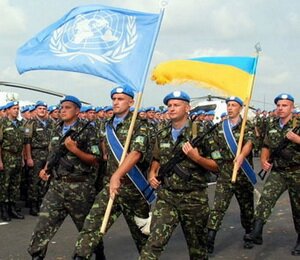
The African continent today is one of the main centers of Ukraine's peacekeeping activity. Lately Ukrainian peacekeepers have been fulfilling tasks in the Democratic Republic of Congo, Liberia, Sudan and South Sudan and Cote d'Ivoire. Recently European Union leaders asked Ukraine to send Ukrainian peacekeepers to Mali. And not only to perform so-called passive functions of keeping peace between the conflicting parties, but also to participate in active combat operations for conciliation or to fight extremist groups. These tasks are put, in particular, on Ukrainian helicopter units that perform a major role in peacekeeping efforts of our state in Africa.
Despite the fact that African events do not have direct influence on Ukraine, its participation in peacekeeping operations in Africa is very important both, for strengthening our international positions, and because of the opportunity to have an access to African markets and natural resources.
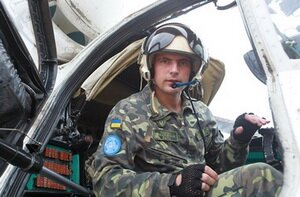 |
| Ukrainian peacekeepers in Africa http://altfast.ru/ |
Thus, a significant Ukrainian peacekeeping potential together with gained peacekeeping experience, attracts attention of leading Western countries and international organizations to cooperation with Ukraine in such an important matter, which, in its turn, compensates the negative political factors that occur around our state. Taking into consideration the leading role of the EU countries in peacekeeping operations in Africa, Ukraine’s proposal can help it in the process of European integration. Besides, participating in peacekeeping activity of the EU, Ukraine acquires experience in joint operations with European countries, most of which are members of both, the European Union and NATO.
Ukraine’s being involved in peacekeeping activities in Africa, will promote cooperation with countries of the region, including in terms of implementation of joint economic projects at their territories, particularly on the development of mineral resources (oil, gas, coal, iron ore, etc), transport and industrial infrastructure and buying agricultural products (coffee, cocoa, citrus, etc). Since African countries are also traditional users of weapons and military equipment of Soviet production and of created on their basis weapons and military equipment samples, these samples can be provided, maintained and modernized by Ukrainian specialists.
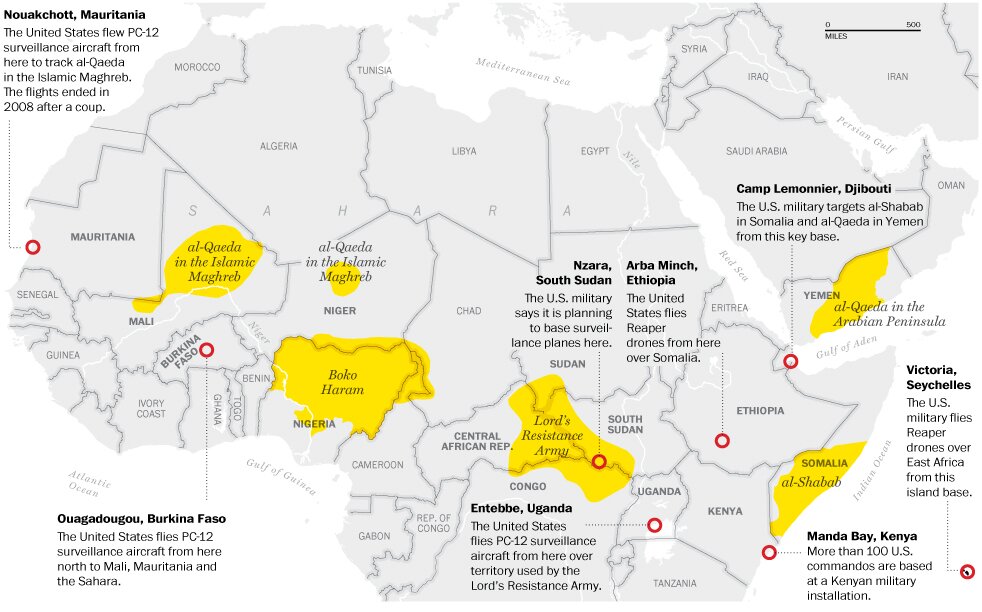
|
| U.S. bases in Africa http://voprosik.net/ |
However, like in other world regions, resolving conflicts in African countries is quite a complicated process, dependent on both, the domestic situation (presence of a wide range of inter-tribal, inter-clan, inter-ethnic and inter-religious conflicts, weakness of government and law enforcement structures of most countries, underdevelopment of infrastructure and industry, etc. ) and negative outer influences, depending on the struggle of leading world countries (including the USA, EU, China and Russia) for their own interests in Africa.
These circumstances determine directions of foreign policy efforts of our state. To make them understandable, we offer our readers general features of the situation in conflict regions of the African continent, where the Ukrainian military units and peacekeepers fulfil their tasks.
Democratic Republic of Congo

|
| Map of the Democratic Republic of Congo http://www.200stran.ru/ |
The main reason for a long-term instability in the Democratic Republic of Congo is the struggle between various Congolese groupings, supported by external forces (foreign countries and corporations) for control over natural resources of North-Eastern parts of the country where there are powerful resources of energy, metals (including rare, precious and radioactive ones), and precious stones. In particular, in the Congolese provinces of North and South Kivu are concentrated up to 80% of the world’s coltan, 50% of cobalt, 35% of diamonds and 20% of uranium.
But because of the remoteness and weak control by the DRC Government, those regions are objects of permanent conflicts between the central leadership and various clans, tribal and criminal groups, who illegally produce, transport and sell minerals from the country. For example, about 32 tons of gold worth about 1.5 billion US dollars, are smuggled from DRC every year. At this, the main smuggling routes of transporting Congolese resources go through neighbouring Rwanda and Uganda (including the participation of government companies of these countries, closely connected with their leaders) to Europe, first of all to Belgium, from where the raw materials go to processing plants of other countries.
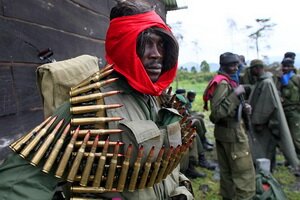 |
| http://drugoi.livejournal.com/ |
In its turn, this leads to constant armed conflicts in the DRC, which have continued since 1960s. At this, while in 1990s the struggle was for access to diamonds, now it is for coltan, which is used in the electronic, chemical, nuclear and medical industries. Taking into consideration absence of significant resources of this element in other parts of the world, it is more profitable than mining and selling diamonds, uranium and gold.
Another aggravation of the internal situation in the Democratic Republic of Congo was in 2008-2009 because of sharpening of confrontation between the government of DRC and the so-called “National Congress of Defense of the Republic “ (CNDR), which unites representatives of tribal groups of the North-East of the country. Thanks to the mediation of the international community, the conflict was formally settled within the framework of the Peace Agreement signed on the 23d of March, 2009, that legitimized authority of CNDR at the territory of controlled by it areas of the country (including the organization’s leaders’ getting a part of profits from the exploitation of natural resources), and also ensured integration of its armed forces into power structures of the DRC.
But the tension in the country remained and, in accordance with UNSC Resolution №1279, from November 30, 2009, the UN Mission in the Democratic Republic of Congo was established. According to the Decree of the President of Ukraine of the 16th of December, 2011, the 18th Separate Helicopter Unit of the Armed Forces of Ukraine with about 160 servicemen and four Mi-24P helicopters was sent to the Mission.
Ukrainian contingent of the UN Mission in the Democratic Republic of Congo
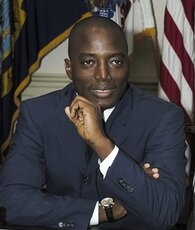 |
|
The fourth President of the Democratic Republic of the Congo - Joseph Kabila Kabange http://ru.wikipedia.org/ |
These measures allowed to some degree to stabilize the situation in the DRC. But in April 2012, the situation in the country again gets complicated due to the President of DRC J. Kabila and his government’s violations of conditions of the above mentioned Agreement. In particular, the Congolese Government decided to nationalize mining companies in the North-East of the country, as well as to meet the demand of the International Criminal Court to give away the leader of the CNDR - General B.Ntahanda, accused of war crimes on civilians.
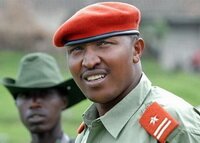 |
| Bosco "Terminator" Ntaganda, Gen. DR Congo one of the commanders of the rebel factions TSNDP http://nekto-ypu.livejournal.com/ |
In response, B.Ntahanda and subordinate to him militias withdrew from the Armed Forces of the DRC and moved to Rwanda, where they created an oppositional to the central Government of DRC “March 23 Movement” (“M23”). Due to the organizational, financial and material assistance to Rwanda and Uganda, there was formed a military wing of the Movement – the “Congolese Revolutionary Army” (CRA).
General management of the process of training of armed formations of CRA was carried out by the Ministry of Defence of Rwanda, while training of militants was carried out on the basis of military units of the Rwandan Army. Besides, Rwanda provided financial support to the “M23” Movement (money from criminal and business structures involved in illegal mining in DRC included).
In June 2012, after the completion of preparatory measures, units of the “Congolese Revolutionary Army”, supported by artillery and special units of the Armed Forces of Rwanda, began attacking units and places of dislocation of the Armed Forces of the DRC in the Eastern districts of the Congolese province of North Kivu. By mid-July 2012, fighters of CRA had actually established control over those regions and launched an offensive in the direction of the administrative province of North Kivu – the town of Homa. At this most of the units of the Armed Forces of DRC were demoralized and left their positions.
Ukrainian soldiers are fighting in Congo
Under such circumstances, the Government of the Democratic Republic of Congo and the leadership of the UN International Mission took immediate steps to hold back actions of militants: sent to the conflict zone additional military forces of the DRC, involved international peacekeeping forces in counter-acting illegal armed formations. In particular, helicopters of the 18th Separate Helicopter Unit of Ukraine’s Armed Forces were involved in patrolling Eastern areas of North Kivu, as well as rocket attacks on places of concentration of militants. In general, these measures stopped the advance of the armed forces of the “Congolese Revolutionary Army” who had to leave the occupied areas.
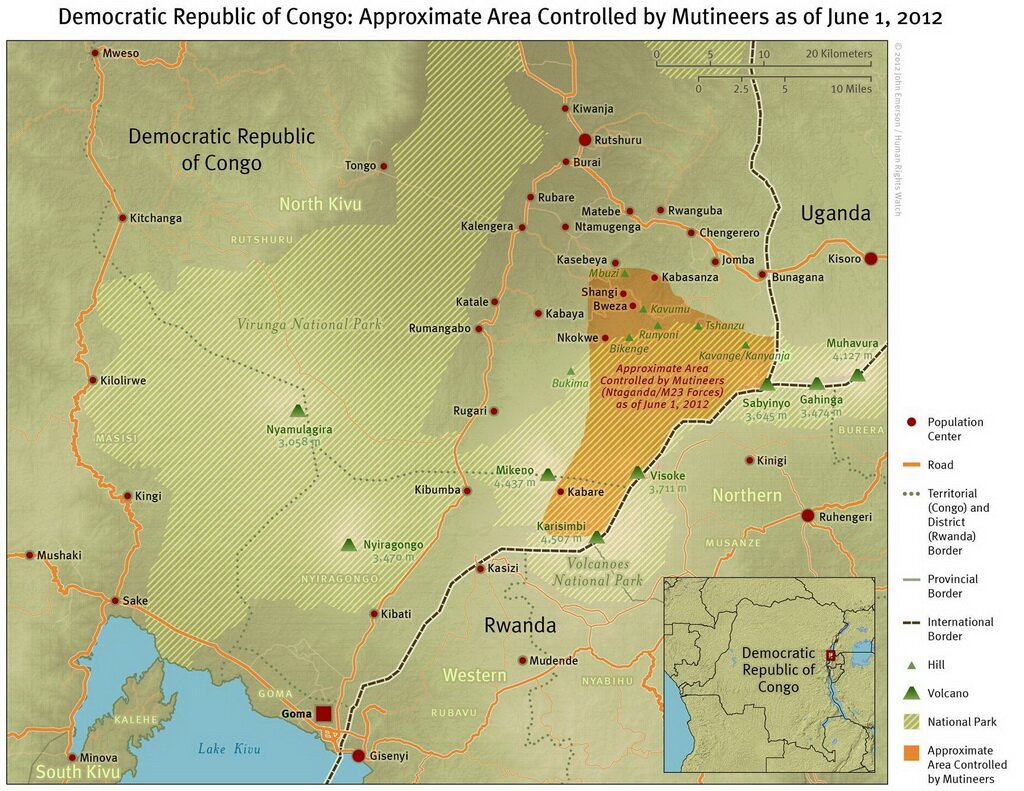
|
| Rebel-controlled Movement of the M23 area of North Kivu, DR Congo http://nekto-ypu.livejournal.com/ |
After regrouping and replenishing their troops in October 2012, CRA restarted its active operations in the province of North Kivu. At this, formations of rebels managed to capture the administrative center of the province Homa (the place of the deployment of the Ukrainian helicopter unit). As in the previous case, the success of the CRA can be explained by the weakness of the Armed Forces of the DRC, including mass defections of military personnel and their transition to the rebels. Thus, unlike the events of June and July 2012, the leadership of the UN International Mission actually gave up active counteractions against rebels that caused a negative reaction of the DRC leadership and local population.
To some extant the situation was settled by the interference of the UN Security Council, which recommended to impose sanctions against the leadership of the “March 23 Movement” and mediation efforts of the “International Conference of the Great Lakes Region”. At the end of November 2012 the leaders of the “M23” movement agreed to withdraw its units from Homa and to begin negotiations with the Government of DRC.
Despite this, the situation in the Democratic Republic of Congo can escalate into a conflict due to the actual lack of progress in resolving contradictions between the Government of the country and the rebels. In particular, the leaders of the “M23” Movement demand early Presidential and Parliamentary elections and the appointment of their representatives to senior positions in the government of the province of North Kivu, to which the DRC Government does not agree.
Against this background, leading Western countries increase pressure on the Government of Rwanda, which provides assistance to “March 23” Movement. Thus, in December 2012 leaders of Great Britain froze annual financial assistance to the Government of Rwanda in the amount of about 30 million US dollars. In its turn, the USA supported the sanctions of the UN SC against the leaders of “M23”.
The threat of a new escalation of violence in the East of the Democratic Republic of Congo remains. Furthermore, additional factors causing the problem in the country are terrorist activity of rebel movements in the states of North and South Kivu, criminal activity of militants of the “Mai-Mai” tribe and of the “God's Resistance Army” Movement, as well as worsening of social-economic problems and a complicated epidemiologic situation in the DRC.
Sudan and the Republic of South Sudan
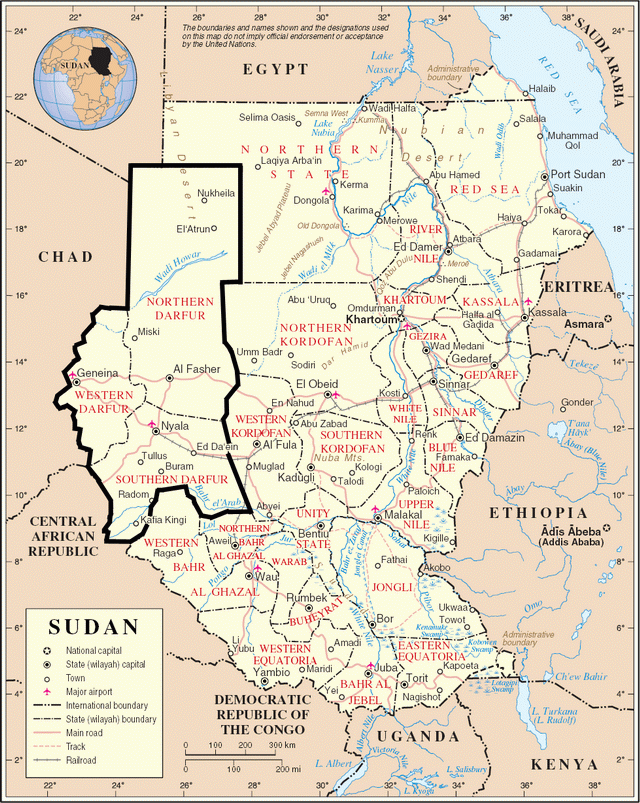
|
| Map of Sudan http://www.200stran.ru/ |
The situation around Sudan and the Republic of South Sudan (RSS) is the most difficult (as compared with situations in other countries of the region) due to contradictions between these countries, unresolved conflicts at their territories and influence of outer forces on them.
Thus, the main problem in relations between Sudan and South Sudan, which emerged after the RSS’ having gained its independence in July of 2011 (as a result of the relevant referendum), remains the unresolved border issues of belonging of a number of border oil areas, especially the district of Abyei. In 2011-2012, this led to a series of border conflicts between the two countries (including the use of heavy military equipment and aviation), which almost grew into a major war. At this, the Armed Forces of Sudan took control of the Abyei district and several other disputed areas, some of which later were taken back by the Armed Forces of South Sudan.
At the same time, the parties use mutual economic pressure, using the oil factor (the main part of oil in the region is produced at the territory of the Southern Sudan and transported to the terminal on the Red Sea via Sudan). In particular, the management of RSS refused to divide the income from oil export under the 50 x 50 scheme and expressed an intention to pay only the tariffs for the oil transit through the territory of Sudan. In response, Sudan stopped transporting South Sudanese oil, and this way caused significant economic losses to both countries and sharpening of their social-economic problems.
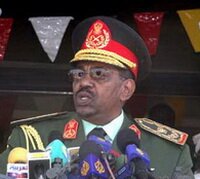 |
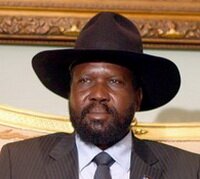 |
| Omar al-Bashir is the President of Sudan http://tribuna.com.ua/ | Salva Kiir is the President of the Republic of South Sudan http://rus.ruvr.ru/ |
To some extent these differences were settled within the package of agreements signed by the President of the Republic of Sudan O.al-Bashir and the President of the Republic of South Sudan S.Kiir in September 2012 under pressure and due to the mediation efforts of the international community (mainly of the United States, China and the UN Security Council). In particular, these agreements provide for the delimitation of the border between the two countries (including division of the most disputed oil-bearing areas), demilitarization of the border zone (abduction of the military subunits of the sides at a distance of at least 100 km off the border), and settlement of issues connected with the distribution of oil incomes and an establishment of relations between the parties in the banking, economic and trade spheres. However, unresolved remains one of the major issues of belonging of Abyei district, which can lead to a conflict between the sides.
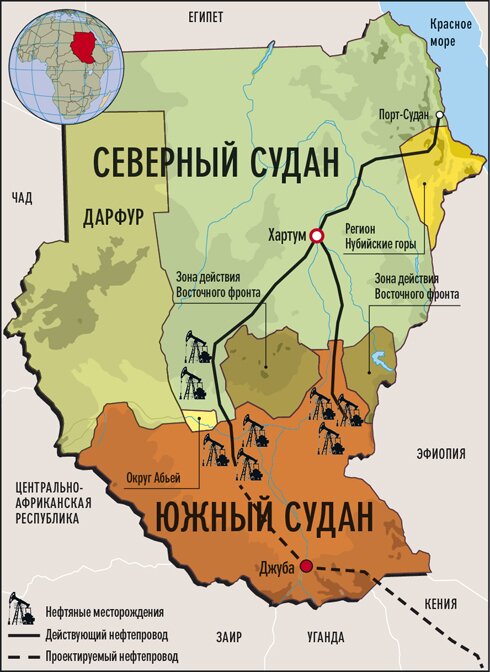
|
|
The Republic of the Sudan and the Republic of South Sudan http://www.profi-forex.org/ |
Internal problems of Sudan and the Republic of South Sudan have also got more complicated. The main among such problems in Sudan, has become uniting the opposition forces on the basis of rebel groups in the Sudanese state of Darfur and neighbouring provinces in the North of the country. In particular, in late 2011, a so-called “Revolutionary Front of Sudan” was created within the framework of the “Sudanese People's Liberation Army – North”, “Movement for Justice and Equality”, and “Sudanese Liberation Movement”, which united against the regime of the country’s President O.al-Bashir. At this, Sudanese opposition forces were supported by the leadership of the Republic of South Sudan, which tried to weaken Sudan in order to settle the territorial conflict between the two countries in its own favour.
In response to the intensification of opposition’s actions, leaders of Sudan activated military operations against rebels in the state of Darfur. Caring about their image in the eyes of the international community, the government of Sudan went to some concessions to the opposition, allowing some of its leaders to return to the country.
 |
| http://drugoi.livejournal.com/ |
Backed by Sudan, rebel movement in the Republic of South Sudan became more active. In particular, the so-called ”Army for the Liberation of South Sudan” focused on undermining the positions of South Sudan’s Government and weakening its power structures (especially in defending the interests of RSS in struggle for disputed territories).
Under such circumstances an important role in solving security problems of the region belongs to United Nations’ peacekeeping activities in Sudan and South Sudan. Today three UN Missions are deployed in the region, namely:
The Mission of the United Nations and the African Union in Darfur, which performs the task of stabilizing the situation in the North of Sudan;
UN Temporary Forces to ensure security in the Abyei (UNISFA), created under UN SC Resolution № 1990 from June 27, 2011. The mission includes four military observers from Ukraine;
The UN Mission in Northern Sudan (UNMISS), established under UN SC Resolution №1996 from July 8, 2011 (replaced the previous United Nations Mission in Sudan - UNMIS in connection with the Government of Sudan’s having refused from its support after the disintegration of the country). Total staff of these missions is about 7 thousand people (civilian and military), including four military observers from Ukraine.
Ukrainian peacekeepers sent to the Republic of South Sudan and Abyei disputed area on the border between Sudan and South Sudan
In general, the activities of these missions helped to avoid a major military confrontation in East Africa that could have significantly affected the entire African region, safety of navigation in the Red Sea, as well as the global energy market.

